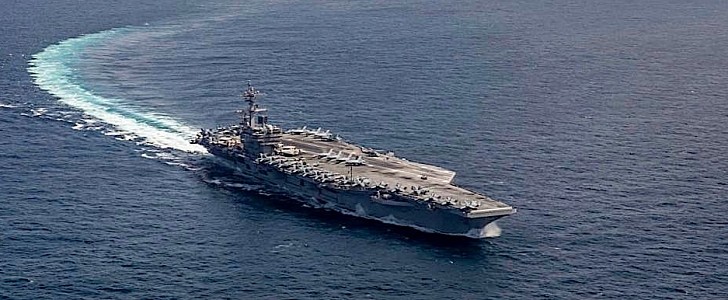Back at the beginning of the year, both the military and the civilian worlds were stunned by images of an F-35 Lightning II slamming into the deck of the USS Carl Vinson, skidding on it, and then dropping into the cold waters of the South China Sea. It was something horrible to look at but, luckily, an incident the kind of which happens very rarely.
Take the USS George H.W. Bush (CVN 77), for instance, and the Carrier Air Wing (CVW) 7 it houses. Together they managed to go through no less than 80,000 catapult launches and an equal number of recoveries, for a total of 160,000 such operations, every single one of them executed to perfection.
The milestone was reached in mid-June, but just now made public. Back then, an E/A-18G Growler deployed with the Electronic Attack Squadron (VAQ) 140 was the 80,000th landing on Bush’s deck, while an E-2D Hawkeye with the Carrier Airborne Early Warning Squadron (VAW) 121 the 80,000th to depart it.
“Eighty-thousand, mishap-free launches and recoveries represent the keen attention to detail, unyielding procedural compliance, and the tremendous magnitude of hard work and effort it takes to keep the catapults and arresting gear running, again and again,” said in a statement Cmdr. Michael Witt, air boss aboard George H.W. Bush.
The USS George H.W. Bush was launched back in 2006 as the last of the Nimitz-class carriers serving the needs of the American military (there are ten in all, including the aforementioned Carl Vinson).
Like all others of its breed, it has a displacement of 114,000 tons, a length of 1,092 feet (333 meters), and is powered by two nuclear reactors.
The carrier is now home to the CVW 7, comprising four strike squadrons (F/A-18F Super Hornets), one electronic attack squadron (EA-18G Growlers), one early warning squadron (E-2D Hawkeye), and a helicopter strike squadron (MH-60 Seahawks).
The Bush carrier strike group (CSG) is presently “completing a certification exercise to increase U.S. and allied interoperability and warfighting capability before a future deployment.”
The milestone was reached in mid-June, but just now made public. Back then, an E/A-18G Growler deployed with the Electronic Attack Squadron (VAQ) 140 was the 80,000th landing on Bush’s deck, while an E-2D Hawkeye with the Carrier Airborne Early Warning Squadron (VAW) 121 the 80,000th to depart it.
“Eighty-thousand, mishap-free launches and recoveries represent the keen attention to detail, unyielding procedural compliance, and the tremendous magnitude of hard work and effort it takes to keep the catapults and arresting gear running, again and again,” said in a statement Cmdr. Michael Witt, air boss aboard George H.W. Bush.
The USS George H.W. Bush was launched back in 2006 as the last of the Nimitz-class carriers serving the needs of the American military (there are ten in all, including the aforementioned Carl Vinson).
Like all others of its breed, it has a displacement of 114,000 tons, a length of 1,092 feet (333 meters), and is powered by two nuclear reactors.
The carrier is now home to the CVW 7, comprising four strike squadrons (F/A-18F Super Hornets), one electronic attack squadron (EA-18G Growlers), one early warning squadron (E-2D Hawkeye), and a helicopter strike squadron (MH-60 Seahawks).
The Bush carrier strike group (CSG) is presently “completing a certification exercise to increase U.S. and allied interoperability and warfighting capability before a future deployment.”











